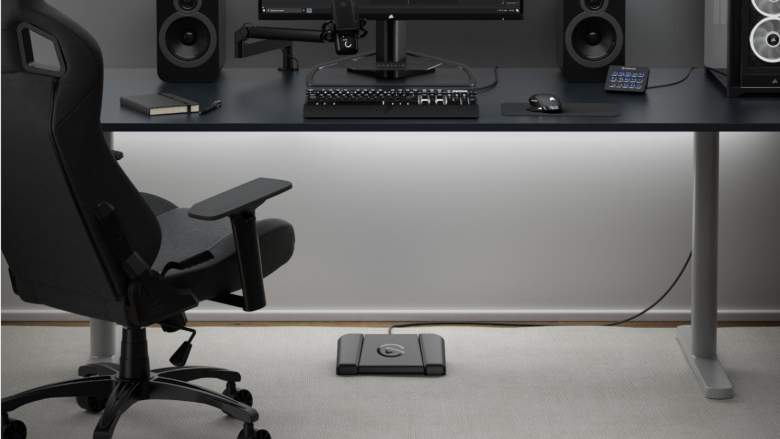
Elgato
Gaming accessories can feel a little over the top sometimes. Companies offer everything from gaming glasses to gaming gloves with claims that they will enhance your gameplay. But I believe there are few gaming accessories that will step your game up more than a PC foot pedal. Connecting a USB foot switch allows you to take some of the mechanical burdens off your fingers so you can do more at once. Check out some of our favorites here.
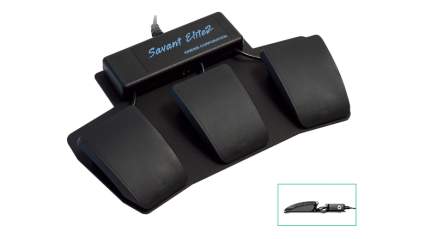
|
Amazon Customer Reviews
|
Price: $205.00 Shop at Amazon | Shop now Read our review |
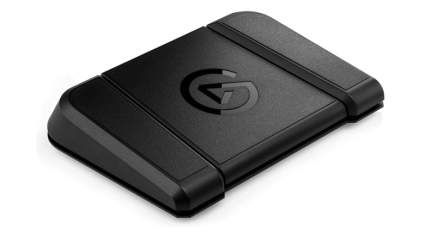
|
Amazon Customer Reviews
|
Price: $77.70 Shop at Amazon | Shop now Read our review |
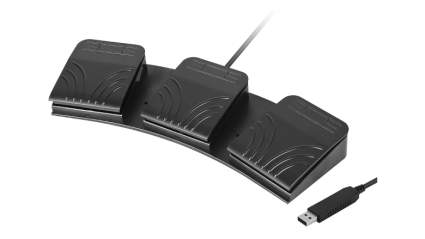
|
Amazon Customer Reviews
|
Price: $39.99 Shop at Amazon | Shop now Read our review |
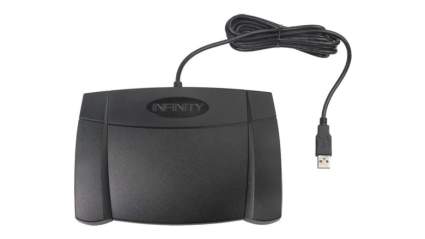
|
Amazon Customer Reviews
|
Price: $64.95 Shop at Amazon | Shop now Read our review |

|
Amazon Customer Reviews
|
Price: $21.99 Shop at Amazon | Shop now Read our review |
-
1. EDITOR’S CHOICE: Kinesis Savant Elite2 Foot Pedal
Pros:- 1/2/3 foot pedals plus expansion slot
- Macro support
- Adjustable pedal force
Cons:- Very high price tag
- Large footprint
- Program mode key is inconveniently placed
The Kinesis Savant Elite2 is a high-end USB foot pedal that comes with either one, two, or three foot pedals. The three-pedal version is the obvious choice for those looking to increase their productivity but the dual-pedal and single-pedal versions each have their merits too. After all, the three-pedal version is fairly pricey and has a large footprint as well.
The pedals themselves have a low profile and a nice gentle curve, so you can easily activate them from a variety of foot placements. They are also bottom-heavy and IPX8-rated for water resistance. One of the coolest features of the Savant Elite2 is its swappable spring system, which allows you to configure your pedal(s) to have different pressure responses. Want more than three pedals? You can connect a second unit using the 3.5mm expansion jack on the side.
The software of the Savant Elite2 doesn’t look pretty but it is quite functional and available for Windows and Mac. You can program each pedal to a different mouse key, mouse button, or controller button if you have a controller connected. You can also program macros and special actions from the OS level like play/pause, volume up, volume down, cut, and paste. In order to program new keys, though, you have to flip a switch on the underside to set it to programming mode, which is a little inconvenient. This is easily forgiven considering all the things I like about this PC foot pedal.
The only real downside you have to reconcile with the Savant Elite2 is the high price tag. But if you are a PC gamer then you should already be used to spending this much money on a shiny new peripheral. A new mechanical keyboard could cost twice as much as this foot pedal kit (though I prefer the cheap ones) and it probably wouldn’t improve your gameplay quite as much as rocking some USB foot pedals.
-
2. Elgato Stream Deck Pedal
Pros:- Supports smart profiles and multi actions
- Powerful plugin support
- Adjustable pedal force
Cons:- Requires software to always be running
- No 1 or 2 pedal versions
- Large footprint
The Elgato Stream Deck Pedal may be specially designed with streamers in mind, but they are so user-friendly and customizable that I think they would make a great PC peripheral for any user seeking to add a new layer of control to their computing.
The hardware on the Stream Deck Pedal is great, but I want to start by talking about the software suite for this device. It is the main feature that sets this PC foot pedal apart from the dozens of generic options that are floating around on Amazon. This software treats this peripheral’s three pedals as new macro buttons rather than emulated button presses of existent keyboard keys, and this unlocks a variety of added uses.
Most impressively, the Stream Deck Pedal software allows Smart Profiles, which are unique layouts that automatically switch depending on which app is active on the screen. An optional popup display provides visual indicators of these so you don’t get confused about switching contexts. You can also program macros or toggle system-level functions like play/pause, volume up, volume down, cut, and paste.
But using the Stream Deck Pedal to just press buttons on your keyboard would be heavily underutilizing this peripheral. The software gives you access to the Stream Deck store where you can install hundreds of free plugins for your favorite apps like IFTTT, VLC, Discord, and more. That way you can load up preset control profiles from the community rather than having to program them yourself.
Returning to the pedals themselves, they feel quite nice to use. They have a somewhat large footprint but they are low-profile and highly customizable. The Stream Deck Pedal comes with interchangeable springs (soft, medium, and hard) so you can configure each pedal’s individual resistance to your liking. You can also use the software to change the actuation point, although the pedals have very little travel compared to something like the Thrustmaster T-LCM USB Foot Pedals.
But for all of these pros, the Stream Deck Pedal has one very annoying con: you have to have the software running in the background for these pedals to function. At best, that means that this peripheral will add a constant but minor strain to your CPU, and at worst, that means your pedals become non-functioning because of a broken software update. Personally, it’s not a deal-breaker for me, but if it is for you, then you are only missing out on some of the most advanced features a PC foot pedal can offer. The competition is still pretty solid.
-
3. iKKEGOL USB Foot Pedal
Pros:- 1/2/3 foot pedals
- Low price tag
- Built-in circuit board
Cons:- No software support for Mac
- No macro support
- Poor documentation
While it isn’t the most feature-packed PC foot pedal I reviewed, the iKKEGOL USB Foot Pedal is a straightforward peripheral that works fine as long as your needs are relatively simple. It comes in a three pedal, two pedal, and one pedal version but I’ve chosen to highlight the three pedal version as it isn’t that much more expensive and still has a relatively small footprint.
The pedals themselves are made of lightweight injection-molded plastic and are easy to depress. The pedals also have a grippy texture on them. Each version comes with detachable rubber feet for use on hard surfaces and a hardwired USB cable. This pedal kit does have its own circuit board built-in, though, so once you program it you don’t have to have the software running in the background to use it.
The FootSwitch software is very bare-bones in appearance but it gets the job done. While the product listing boasts Mac and Linux support (which is technically true), the software suite is not available on these OSes so you need a Windows device to at least configure the device before you use it on a different OS.
The software allows you to program each pedal to an existent key, mouse button, or controller button. The software also allows you to register the pedal to some basic OS functions, so you can also pair them directly to play/pause, volume up, volume down, cut, or paste. The software does not support macros (multiple key presses at once) but it does support strings (multiple key presses in sequence). The feature is pretty much garbage so consider a different PC foot pedal if you want to execute complex functions.
That said, if all you need is a simple and inexpensive peripheral for push-to-talk or play/pause, then the iKKEGOL USB foot pedal is a great value choice.
-
4. Executive Communication Systems Infinity 3
Pros:- Ergonomic 3-button layout
- Plug-and-play for transcription
- Macro support
Cons:- Large footprint
- No 1 or 2 pedal versions
- Limited software customization
If you are looking for a PC foot pedal that is ideal for professionally transcribing videos, the Executive Communication Systems Infinity 3 should be at the top of your list. But even if you have a different application in mind, this is still a solid foot-powered peripheral option.
In terms of form factor, the Infinity 3 has a fairly large footprint but it also has a low-profile layout that makes it easy to depress its pedals from a number of different sitting positions. The best way to use this pedal is by resting one foot on the central, sloping pedal and then sliding that foot to one of the raised side pedals to use the secondary and tertiary actions.
This pedal is pre-programmed to work right out of the box with all of the most popular transcription software such as Express Scribe, Rev, and Nuance. As such, it doesn’t ship with any configuration software of its own. Most users use a free software called Pedable, which allows the Infinity 3 to be used to simulate keys or mouse clicks, insert custom text, or open particular programs. It can also run macros with a little bit of finagling.
Unfortunately, it must run in the background, which can be taxing on older CPUs and can mean a non-functioning pedal if the company’s software ever breaks. It might need to be run in compatibility mode on newer Windows devices. On that note, this is only the case if you aren’t using it for transcription software, for which it is plug-and-play. If smoother transcription is your ultimate goal, then this is a solid choice. If not, you may be better off with the Elgato Stream Deck Pedal, which has the same software-based limitations but with a lot more functionality.
-
5. Programmable Macro USB Button
Pros:- Made with an Otemu red switch
- Small footprint
- Low price tag
Cons:- Not ergonomically designed for feet
- Only one button
- No macro support
Okay, while this Programmable Macro USB Button isn’t ergonomically designed to be pressed by a foot, it is still an ultra low-footprint option for those who don’t want to crowd the space under their desk with a whole complex setup just so they can press their push-to-talk button without their hands.
There isn’t much to say about the build quality except that this peripheral is basically a one-button mechanical keyboard with a hot-swappable red switch and a built-in RGB LED. The LED cannot be controlled but rather just cycles through its lights when pressed. It connects via USB and comes with a 3-foot USB cable. If your computer isn’t already on the ground then you may want a longer cable.
The website for the software is incredibly sketchy but the software works for what you need it to do, which is to assign which button on your keyboard or mouse that you want this peripheral to emulate. The software is only needed to configure the button and not to make it function. I was not able to test if this button worked on Mac and Linux devices but the software is an executable so it theoretically should work on any OS.
Even if all you wanted was a simple one-button PC foot pedal, I would still probably recommend the one pedal version of the iKKEGOL USB footswitch before I recommended this one. That said, the compact design of this Programmable Macro USB Button is unique enough that it may fit perfectly for some specific uses out there. And for that reason, it is still a viable choice for some users.
How to Use a PC Foot Pedal
There is no doubt that a PC foot pedal is a valuable accessory for PC power users but it is such a versatile tool that you may find yourself lost on exactly how to utilize yours. Some of my favorite uses are for PC gaming but a PC foot pedal can also come in handy for controlling other software. Here are a few examples from both camps.
Push-To-Talk
Using a PC foot pedal as your push-to-talk button for Discord is one of the most popular applications of this peripheral. By moving your push-to-talk to a rarely used keyboard key and then binding it to a foot pedal, you won't have to worry about accidentally rebinding a crucial key used by your favorite games.
Additionally, you won't have to take your fingers off your controller if you use a controller. The same goes for WASD if you use a keyboard.
Streaming
Just like with chat programs, streaming programs like Streamlabs OBS and Wirecast can require lots of extra inputs on top of whatever software you are streaming. Assigning some of these commands to a foot pedal will free up commands on your keyboard so that you aren't inhibited in your number of possible inputs.
Driving Games
A triple USB foot pedal is the ideal peripheral for emulating a real gas pedal, brake pedal, and clutch, especially if it is one that supports variable pressure. Yes, there are plenty of specially made pedal sets out there for sim racing but almost none of them can be customized for other uses. Conversely, you really don't need a specialized set of pedals to get a more immersive driving sim experience. Any of these picks could work as long as they have at least two pedals.
Transcription
According to researchers at Grand Review Research, the professional transcription market has been steadily growing over time and it isn't slated to stop anytime soon. And PC foot pedals are a big way to up your speed in transcribing. The logic is that by offloading the play/pause and tracking controls to your feet, you can keep both hands on the home row for more efficient typing. Makes sense to me.
Audio Production
USB foot pedals make great MIDI triggers, especially if you usually have your hands on an instrument while you are recording. The controllers I reviewed above could technically work as MIDI Controllers too but if you are at all serious about digital music production, I would recommend looking at dedicated MIDI foot controllers for the added utility they have with certain DAWs and amps.
Other Uses
As I said, there are simply too many applications to list for these versatile devices! Your imagination is the only limit in most cases, so experiment with what works best for you. I put my PC foot pedals to the most rigorous use in mil-sim shooters like Escape From Tarkov, where I can bind the pedals to lean left, hold breath, and lean right.
If you find a unique use for your PC foot pedal, write me an email telling me about it and I might just add it to this list.